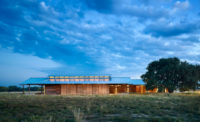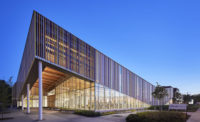Wednesday the AIA Committee on the Environment (COTE) announced the recipients of the 2017 COTE Top Ten Awards. The announcement marks the 21st year of the program, which recognizes buildings that wed superior design and sustainable performance. It also follows on the heels of the AIA’s release of “Where we stand: climate change,” a set of eight principles guiding architects’ response to global warming.
“I think these are incredible role models for architects—they address climate change in aggressive and progressive ways,” Top Ten juror and International Living Future Institute CEO Amanda Sturgeon says of the honorees.
On the timing of the awards and the AIA statement of environmental principles, Sturgeon notes, “People are inspired by examples and positive solutions more than mandates, but they’re both needed. The Top Ten reinforces that those principles are realizable and beautiful.” Sturgeon’s fellow jurors included architects Annie Chu, Steve Kieran, and David Lake, and engineer Bungane Mehlomakulu.
Top Ten evaluation criteria underwent a significant revamping for this year’s awards cycle to reflect Lessons From the Leading Edge, an analysis of previous Top Ten winners by Lance Hosey that the AIA published last year. This year’s application emphasized actual performance, as well as metrics concerning occupant health and comfort, resilience, and economic sustainability. Measurement of carbon footprint now more strongly incorporates emissions associated with a building’s construction, subsequent operation, and users’ commutes.
Besides abiding the new submission, several commonalities distinguish the 2017 Top Ten. Because they are owned for long periods and used as pedagogical tools, Sturgeon says, “education projects have been at the leading edge of sustainability since the early days”; five higher-education facilities and the VMDO Architects–designed Discovery Elementary School in Arlington, Virginia, earned slots in the Top Ten. The awards pool also includes a hospital, two public buildings, and an environmental center. Sturgeon adds that the winners more uniformly embody cutting-edge sustainability initiatives like net-zero and net-positive performance.
The 2017 Top Ten dovetails with another AIA report, The Habits of High-Performance Firms, which Hosey co-authored with Sandra Montalbo. Released last month, the survey encompasses the 29 of the 130 architecture firms that ranked in the Top Ten more than once between 1997 and 2016. While several of these firms, such as HOK and Mithun, were recognized again this year, Sturgeon observes, “There were a few names who are quite new to me, which, the ubiquity of higher performance standards, means sustainability is becoming more mainstream.”
The 2017 Top Ten projects will be celebrated at multiple events at the 2017 AIA Conference on Architecture in Orlando next week.
























Post a comment to this article
Report Abusive Comment